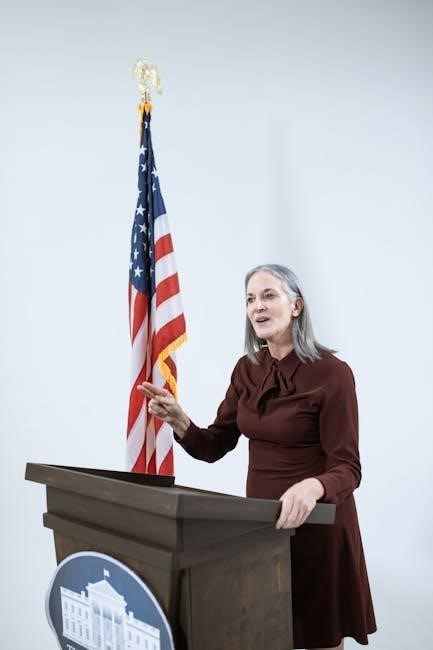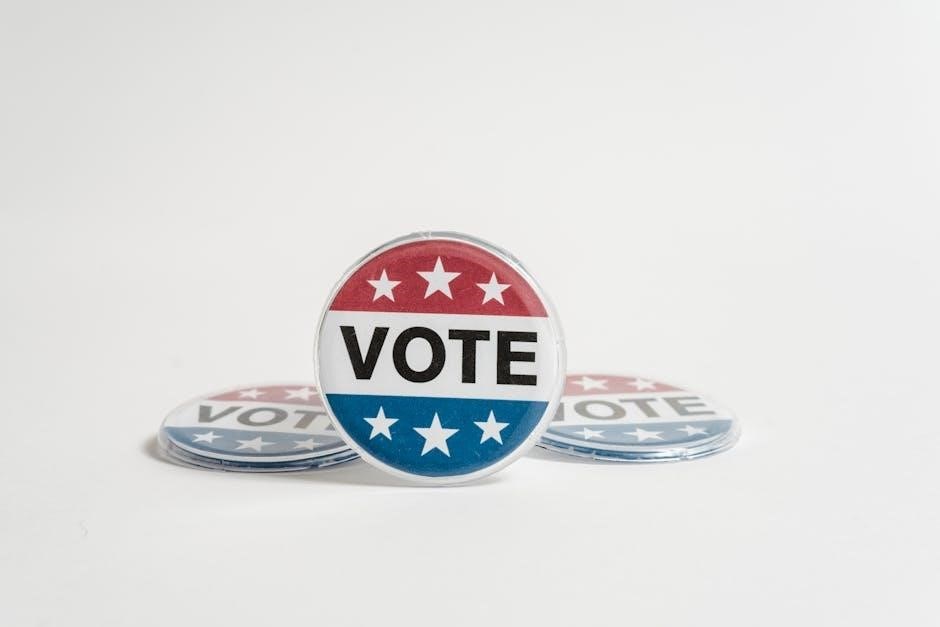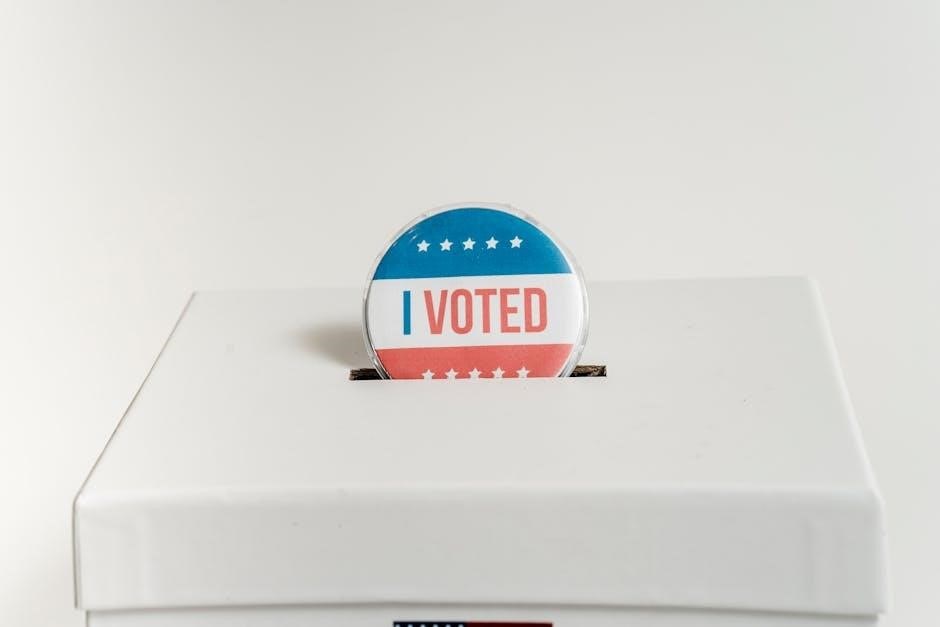Foundations of U.S. Democracy
The Constitution establishes the framework of U.S. democracy, emphasizing federalism, separation of powers, and checks and balances. It ensures civil liberties and rights, fostering civic participation and accountability. This foundational document, explored in United States Government: Our Democracy, shapes the nation’s governance and citizen engagement, promoting democracy and the rule of law.
The Constitution and Its Significance
The Constitution is the cornerstone of U.S. democracy, outlining the framework of federalism, separation of powers, and checks and balances. Adopted in 1789, it replaced the Articles of Confederation, establishing the United States as a federal union of states with a representative democracy. The document ensures the protection of civil liberties and rights, while also providing mechanisms for governance and accountability. As detailed in United States Government: Our Democracy, the Constitution’s significance lies in its ability to adapt to societal changes through amendments, such as the 13th, 14th, and 15th Amendments, which addressed civil rights and equality. This foundational text remains central to understanding the structure, function, and evolution of American democracy, emphasizing the importance of civic participation and the rule of law.
The Bill of Rights: Ensuring Individual Liberties
The Bill of Rights, comprising the first ten amendments to the Constitution, safeguards fundamental individual liberties and limits government power. These amendments guarantee freedoms such as speech, religion, and the press, while also protecting against unreasonable searches and seizures. The right to a fair trial, freedom from cruel and unusual punishment, and the protection of property rights are also enshrined. As explained in United States Government: Our Democracy, these liberties are essential to maintaining a just and free society. The Bill of Rights ensures that citizens’ freedoms are not infringed upon by the government, fostering a balance between individual rights and governmental authority. This foundational aspect of U.S. democracy is crucial for promoting civic engagement and upholding the principles of justice and equality.
Federalism: Division of Powers Between State and Federal Governments
Federalism is a cornerstone of U.S. democracy, dividing power between the federal government and state governments. The Constitution establishes this system, ensuring that powers not delegated to the federal government are reserved for the states or the people. This division allows for a balance of authority, with the federal government handling national and foreign affairs, while states manage local matters like education and law enforcement. The concept of shared powers, such as taxation and legislation, further strengthens this framework. Federalism promotes regional autonomy and accountability, preventing centralized control. As discussed in United States Government: Our Democracy, this system fosters cooperation and competition between levels of government, ensuring efficient governance while protecting individual and state rights. It remains a vital component of the U.S. political structure, enabling adaptability and responsiveness to diverse needs across the nation.

Structure of the U.S. Government
The U.S. government is divided into three branches: legislative, executive, and judicial. This structure ensures accountability and representation, as outlined in United States Government: Our Democracy.
The Three Branches of Government: Legislative, Executive, Judicial
The U.S. government is structured into three branches: legislative, executive, and judicial. The legislative branch, composed of Congress (House and Senate), creates laws. The executive branch, led by the President, enforces laws. The judicial branch, headed by the Supreme Court, interprets laws. This system ensures checks and balances, preventing any single branch from abusing power. The separation of powers promotes accountability and protects individual rights. This structure is detailed in United States Government: Our Democracy, emphasizing the importance of each branch’s role in maintaining democracy and governance. By dividing authority, the framework ensures efficient and balanced governance, reflecting the principles of federalism and constitutional design.
Checks and Balances: Maintaining Government Accountability
The system of checks and balances ensures that no branch of government exceeds its authority, maintaining accountability and preventing abuse of power. Congress can impeach and remove the President, while the President can veto legislation. The judiciary reviews laws for constitutionality, ensuring they align with democratic principles. These mechanisms, detailed in United States Government: Our Democracy, protect against tyranny and promote fairness. By dividing power, the system safeguards individual rights and upholds the rule of law, fostering a balanced governance structure essential for democracy.
State and Local Governments: Their Roles and Responsibilities
State and local governments play a vital role in the federal system, addressing issues closest to citizens’ daily lives. They oversee education, public safety, transportation, and healthcare, ensuring services are tailored to local needs. These governments levy taxes, allocate budgets, and enforce laws within their jurisdictions. The textbook United States Government: Our Democracy highlights how state and local authorities collaborate with the federal government while maintaining autonomy. This division of responsibilities ensures efficient governance and accountability, empowering communities to address unique challenges. By balancing local decision-making with federal oversight, state and local governments uphold democratic principles and foster civic engagement at the grassroots level.

Civil Rights and Liberties
The 13th, 14th, and 15th Amendments abolished slavery, granted citizenship, and protected voting rights, while civil liberties like free speech and religion remain cornerstone principles of American democracy.
The 13th, 14th, and 15th Amendments: Landmarks in Civil Rights
The 13th Amendment abolished slavery and involuntary servitude, marking a pivotal step in the fight for equality. The 14th Amendment granted citizenship to former slaves and ensured equal protection under the law, while the 15th Amendment protected voting rights for African American men. These amendments laid the groundwork for civil rights advancements, addressing systemic injustices and expanding democratic participation. As highlighted in United States Government: Our Democracy, these constitutional changes were instrumental in reshaping the nation’s commitment to freedom and equality, setting the stage for future civil rights movements and legal reforms.
Civil Liberties: Freedom of Speech, Religion, and the Press
Civil liberties, including freedom of speech, religion, and the press, are foundational to U.S. democracy. The First Amendment safeguards these rights, ensuring citizens can express opinions, practice faith, and access information without government interference. These liberties are essential for a free society, fostering debate, religious freedom, and a well-informed public. The United States Government: Our Democracy textbook highlights how these rights are protected and their significance in maintaining democratic values. Supreme Court cases have further defined these liberties, ensuring their application aligns with constitutional principles. By upholding these freedoms, the U.S. promotes individual autonomy and collective progress, reflecting the nation’s commitment to democracy and human rights.
Modern Civil Rights Movements: Struggles and Achievements
Modern civil rights movements in the U.S. have focused on addressing systemic inequalities and expanding rights for marginalized groups. The Civil Rights Movement of the 1950s and 1960s was pivotal, achieving landmark legislation such as the Civil Rights Act of 1964 and the Voting Rights Act of 1965. These laws prohibited racial segregation and protected voting rights, marking significant progress. However, challenges persisted, including resistance to implementation and ongoing discrimination. The movement inspired others, such as the women’s rights, LGBTQ+ rights, and disability rights movements, to advocate for equality. Despite achievements, modern struggles continue, with issues like voter suppression and systemic inequality remaining. The United States Government: Our Democracy textbook emphasizes the importance of civic engagement and the ongoing fight for justice, highlighting both progress and the work still needed to ensure true equality for all.

The Role of Media in Politics
The media significantly influences public opinion and policy by disseminating information, holding governments accountable, and shaping political narratives. However, challenges like fake news and bias persist, impacting trust and accuracy.
Media Influence on Public Opinion and Policy

The media plays a crucial role in shaping public opinion and influencing policy decisions in the United States. Through various platforms, it disseminates information, highlights key issues, and frames narratives that affect how citizens perceive government actions and policies. As discussed in United States Government: Our Democracy, the media’s ability to set agendas ensures that certain topics gain prominence, influencing both public discourse and legislative priorities. For instance, extensive coverage of environmental issues can push policymakers to address climate change more urgently. Additionally, the media’s framing of events can sway public sentiment, either supporting or criticizing government decisions. However, challenges like misinformation and bias can undermine this influence, leading to polarization and mistrust. Despite these issues, the media remains a vital link between the government and the people, fostering accountability and engagement in the democratic process.
Challenges of Modern Media: Fake News and Bias
Modern media faces significant challenges, including the spread of fake news and inherent bias, which undermine public trust and democratic processes. Fake news, often disseminated through social media platforms, can mislead citizens and distort their understanding of critical issues. As highlighted in United States Government: Our Democracy, such misinformation can influence elections and policy debates, threatening the integrity of democratic institutions. Additionally, media bias, whether perceived or real, further polarizes the public by presenting one-sided narratives. This erosion of trust in media institutions complicates the dissemination of accurate information, essential for informed decision-making. Addressing these challenges requires fostering media literacy, promoting fact-based reporting, and encouraging transparency in news sources. Only through these efforts can the media fulfill its role as a reliable informant and watchdog in a functioning democracy.
Media’s Role in Holding the Government Accountable
The media plays a vital role in ensuring government accountability by acting as a watchdog, monitoring governmental actions, and reporting on issues that impact the public interest. As discussed in United States Government: Our Democracy, a free and independent press is essential for transparency, uncovering misconduct, and holding officials responsible for their actions. By investigating and reporting on government decisions, policies, and practices, the media empowers citizens with the information needed to make informed decisions and demand accountability. This scrutiny helps prevent abuse of power and ensures that elected officials remain answerable to the people. However, challenges such as political pressures and misinformation can hinder the media’s effectiveness, making it crucial for journalists to maintain ethical standards and commitment to truth. A robust media is indispensable for upholding democratic principles and fostering trust in government institutions.

Political Parties and Interest Groups
Political parties, such as Democrats and Republicans, and interest groups significantly influence policy-making through lobbying and PACs, shaping U.S. democracy as detailed in the textbook.
Major Political Parties: Democrats and Republicans
The United States operates under a two-party system, dominated by the Democratic and Republican parties. These parties shape national politics, policy-making, and voter alignment. The Democratic Party generally advocates for progressive reforms, social welfare, and government intervention in the economy. In contrast, the Republican Party emphasizes conservatism, limited government, and free-market principles. Both parties play crucial roles in elections, legislative processes, and shaping public policy. The textbook United States Government: Our Democracy provides insights into their historical development, ideological differences, and impacts on governance. These parties influence voter behavior, campaign strategies, and the direction of the country, reflecting the diverse interests and values of American society. Their rivalry and cooperation are central to the functioning of U.S. democracy.
Interest Groups: Their Impact on Policy Making
Interest groups play a significant role in shaping U.S. policy by influencing decision-makers and public opinion. These groups, representing diverse interests, aim to impact legislation and regulations that align with their goals. They employ various strategies, including lobbying, grassroots mobilization, and campaign contributions, to sway policymakers. The textbook United States Government: Our Democracy explores how these groups navigate the political landscape to advance their agendas. By focusing on specific issues, interest groups often amplify the voices of their members, ensuring their concerns are heard in the legislative process. This dynamic highlights the complex interplay between advocacy and governance, demonstrating how interest groups contribute to the democratic process while sometimes raising ethical concerns about unequal influence. Understanding their role is crucial for grasping how policies are formulated and prioritized in the U.S. political system.
The Role of PACs and Lobbying in Politics

Political Action Committees (PACs) and lobbying are central to the U.S. political process, enabling organized groups to influence policy and elections. PACs pool contributions from individuals or organizations to support candidates who align with their interests. Lobbying involves direct advocacy to policymakers, often by corporations, unions, or non-profits, to shape legislation. The textbook United States Government: Our Democracy highlights how these activities amplify voices in the political arena. While PACs and lobbying provide a means for representation, they also raise concerns about unequal influence and potential corruption. These practices underscore the complexities of democracy, where money and access can significantly impact policy outcomes. Understanding their roles is essential for evaluating the balance between representation and equity in U.S. governance.

The Electoral Process
The Electoral College system plays a critical role in U.S. elections, determining the president through state allocations. Campaign finance and voter participation trends significantly influence election outcomes and democracy’s functionality.
The Electoral College System: How It Works
The Electoral College is a unique mechanism for electing the U.S. President, established by the Constitution. Each state is allocated a certain number of electoral votes based on its population, with a total of 538 votes available. During a presidential election, voters in each state cast ballots for a candidate, and the majority winner in that state typically receives all of its electoral votes, except in Maine and Nebraska, which allocate votes proportionally. A candidate needs at least 270 electoral votes to win the presidency. This system ensures that both populous and less populated states have a voice in the election process, balancing regional interests with national outcomes. The Electoral College system is detailed in textbooks like United States Government: Our Democracy, which provides insights into its historical roots and contemporary implications.
Campaign Finance: Funding Elections
Campaign finance plays a critical role in U.S. elections, shaping how candidates raise and spend money to compete for office. The system allows candidates to collect funds from individual donors, political action committees (PACs), and party organizations, with legal limits on contribution amounts. The Federal Election Commission (FEC) oversees these activities, ensuring compliance with disclosure requirements and spending laws. Supreme Court decisions, such as Citizens United v. FEC, have significantly influenced campaign finance by allowing corporations and unions to spend unlimited amounts on independent political expenditures. This has led to the rise of Super PACs, which can raise and spend large sums of money. The debate over campaign finance reform continues, with arguments focusing on reducing corruption, increasing transparency, and leveling the playing field. United States Government: Our Democracy explores these dynamics in detail.
Voter Participation: Trends and Challenges
Voter participation in U.S. elections has seen varying trends over the years, with turnout increasing in recent presidential elections, particularly among diverse demographic groups. However, challenges such as voter suppression, gerrymandering, and limited access to polling stations persist. The rise of mail-in and early voting options has expanded opportunities for citizens to cast ballots, boosting participation. Despite these efforts, disparities remain, with lower turnout often observed in minority and low-income communities. Civic education and voter registration drives play a crucial role in addressing these gaps. United States Government: Our Democracy highlights the importance of addressing systemic barriers to ensure equitable voting rights and foster a more inclusive democracy.

The Judiciary and Its Impact
The judiciary interprets laws and the Constitution, ensuring justice and fairness. Through judicial review, courts shape policies and protect rights, with landmark cases significantly influencing American democracy and governance.
The Supreme Court: Its Role and Landmark Cases
The Supreme Court is the highest judicial body in the U.S., interpreting the Constitution and federal laws. Its landmark cases, such as Marbury v. Madison, established judicial review, shaping constitutional interpretation. Brown v. Board of Education ended racial segregation, while Roe v. Wade addressed individual rights. These decisions have profoundly influenced civil rights, liberties, and national policy, reflecting the Court’s critical role in upholding democracy and justice. The Supreme Court’s rulings ensure consistency with the Constitution, maintaining the balance of power and protecting individual freedoms, as detailed in United States Government: Our Democracy.
Judicial Review: Shaping Constitutional Interpretation
Judicial review is the Supreme Court’s authority to interpret the Constitution and determine the validity of laws and government actions. This power, established in Marbury v. Madison, ensures that laws align with constitutional principles. Through judicial review, the Court has shaped key policies, such as civil rights and individual freedoms. Landmark rulings have expanded or limited government authority, reflecting evolving societal values. United States Government: Our Democracy highlights how judicial review maintains the balance of power and protects rights, ensuring that the Constitution remains a living document. This process is vital to upholding democracy, as it ensures no branch of government exceeds its constitutional limits, while safeguarding the rights of citizens.
The Federal Court System: Structure and Function
The U.S. federal court system is a hierarchical structure designed to ensure justice and uphold the rule of law. It consists of three main levels: the Supreme Court, the Circuit Courts of Appeals, and the District Courts. The District Courts serve as the trial courts, handling cases involving federal laws and the Constitution. The Circuit Courts of Appeals review decisions from the District Courts, while the Supreme Court, as the highest court, interprets the Constitution and resolves major legal disputes. This system ensures a clear hierarchy and division of responsibilities, allowing for efficient adjudication of cases. The federal courts play a crucial role in maintaining the integrity of the legal system, resolving disputes, and interpreting laws to ensure fairness and justice for all citizens.

Global Implications of U.S. Democracy
The United States’ democratic model influences global governance, promoting democratic values and shaping international relations. Its policies and ideals impact global stability, human rights, and economic systems worldwide.
U.S. Foreign Policy: Promoting Democracy Abroad
U.S. foreign policy has historically emphasized the promotion of democracy worldwide, aligning with its founding principles of freedom and self-governance. Through diplomatic efforts, economic aid, and international alliances, the United States supports democratic institutions and human rights globally. This approach is rooted in the belief that democratic nations are more stable, peaceful, and prosperous. However, challenges arise, such as balancing national interests with humanitarian goals and addressing criticism of hypocrisy in certain foreign interventions. Despite these complexities, the U.S. continues to advocate for democratic values, influencing global governance and inspiring movements for political reform. This commitment reflects the nation’s role as a global leader in fostering democracy and shaping international relations.
Global Perspectives on American Democracy
Global perspectives on American democracy vary widely, reflecting diverse cultural, political, and historical contexts. Many view the U.S. as a symbol of democratic ideals, admiring its constitutional framework and civil liberties. Others criticize perceived inconsistencies, such as racial inequality and political polarization, which contrast with its professed values. In some regions, American democracy is seen as a model for emulation, while in others, it is viewed with skepticism due to past and present foreign policy actions. The global community often looks to the U.S. for leadership in promoting democracy, yet its influence is tempered by critiques of hypocrisy and self-interest. These varied viewpoints highlight the complex and multifaceted nature of American democracy on the world stage.
Challenges to Democracy in a Globalized World
Globalization presents significant challenges to democracy, including economic inequality, political polarization, and the influence of non-state actors. The rise of multinational corporations and international organizations often diminishes the power of national governments, making it harder for citizens to hold decision-makers accountable. Additionally, cultural homogenization and the spread of misinformation through global media outlets can erode trust in democratic institutions. The increasing interconnectedness of the world also raises questions about the balance between national sovereignty and global cooperation. These challenges require democracies to adapt and find innovative ways to ensure equitable representation, transparency, and accountability in an ever-changing global landscape. Addressing these issues is crucial to maintaining the integrity and effectiveness of democratic systems worldwide.
